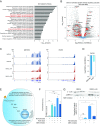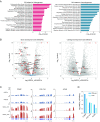Widespread changes in transcriptome profile of human mesenchymal stem cells induced by two-dimensional nanosilicates
- PMID: 29643075
- PMCID: PMC5924886
- DOI: 10.1073/pnas.1716164115
Widespread changes in transcriptome profile of human mesenchymal stem cells induced by two-dimensional nanosilicates
Abstract
Two-dimensional nanomaterials, an ultrathin class of materials such as graphene, nanoclays, transition metal dichalcogenides (TMDs), and transition metal oxides (TMOs), have emerged as a new generation of materials due to their unique properties relative to macroscale counterparts. However, little is known about the transcriptome dynamics following exposure to these nanomaterials. Here, we investigate the interactions of 2D nanosilicates, a layered clay, with human mesenchymal stem cells (hMSCs) at the whole-transcriptome level by high-throughput sequencing (RNA-seq). Analysis of cell-nanosilicate interactions by monitoring changes in transcriptome profile uncovered key biophysical and biochemical cellular pathways triggered by nanosilicates. A widespread alteration of genes was observed due to nanosilicate exposure as more than 4,000 genes were differentially expressed. The change in mRNA expression levels revealed clathrin-mediated endocytosis of nanosilicates. Nanosilicate attachment to the cell membrane and subsequent cellular internalization activated stress-responsive pathways such as mitogen-activated protein kinase (MAPK), which subsequently directed hMSC differentiation toward osteogenic and chondrogenic lineages. This study provides transcriptomic insight on the role of surface-mediated cellular signaling triggered by nanomaterials and enables development of nanomaterials-based therapeutics for regenerative medicine. This approach in understanding nanomaterial-cell interactions illustrates how change in transcriptomic profile can predict downstream effects following nanomaterial treatment.
Keywords: 2D nanomaterials; RNA-seq; human mesenchymal stem cells; nanosilicates; whole-transcriptome sequencing.
Copyright © 2018 the Author(s). Published by PNAS.
Conflict of interest statement
Conflict of interest statement: J.K.C. and A.K.G. are coauthors on US Patent Application No. WO2017112802 A1 published on June 29, 2017 (US Provisional Patent Application No. 62/270,403 filed on December 21, 2015).
Figures




Similar articles
-
Inorganic Biomaterials Shape the Transcriptome Profile to Induce Endochondral Differentiation.Adv Sci (Weinh). 2024 Aug;11(29):e2402468. doi: 10.1002/advs.202402468. Epub 2024 May 13. Adv Sci (Weinh). 2024. PMID: 38738803 Free PMC article.
-
Sustained and Prolonged Delivery of Protein Therapeutics from Two-Dimensional Nanosilicates.ACS Appl Mater Interfaces. 2019 Feb 20;11(7):6741-6750. doi: 10.1021/acsami.8b17733. Epub 2019 Jan 24. ACS Appl Mater Interfaces. 2019. PMID: 30676016 Free PMC article.
-
Elastomeric and mechanically stiff nanocomposites from poly(glycerol sebacate) and bioactive nanosilicates.Acta Biomater. 2015 Oct;26:34-44. doi: 10.1016/j.actbio.2015.08.025. Epub 2015 Aug 19. Acta Biomater. 2015. PMID: 26297886
-
Selenium Nanoparticles by Moderating Oxidative Stress Promote Differentiation of Mesenchymal Stem Cells to Osteoblasts.Int J Nanomedicine. 2021 Jan 13;16:331-343. doi: 10.2147/IJN.S285233. eCollection 2021. Int J Nanomedicine. 2021. PMID: 33488075 Free PMC article.
-
2D Materials-Based Aptamer Biosensors: Present Status and Way Forward.Curr Med Chem. 2022;29(37):5815-5849. doi: 10.2174/0929867328666211213115723. Curr Med Chem. 2022. PMID: 34961455 Review.
Cited by
-
Secretomes from Mesenchymal Stem Cells against Acute Kidney Injury: Possible Heterogeneity.Stem Cells Int. 2018 Dec 16;2018:8693137. doi: 10.1155/2018/8693137. eCollection 2018. Stem Cells Int. 2018. PMID: 30651737 Free PMC article. Review.
-
2D Nanoclay for Biomedical Applications: Regenerative Medicine, Therapeutic Delivery, and Additive Manufacturing.Adv Mater. 2019 Jun;31(23):e1900332. doi: 10.1002/adma.201900332. Epub 2019 Apr 3. Adv Mater. 2019. PMID: 30941811 Free PMC article. Review.
-
Gelatin Hydrogels Reinforced by Absorbable Nanoparticles and Fibrils Cured In Situ by Visible Light for Tissue Adhesive Applications.Polymers (Basel). 2020 May 13;12(5):1113. doi: 10.3390/polym12051113. Polymers (Basel). 2020. PMID: 32414044 Free PMC article.
-
Two-dimensional nanomaterials for bone disease therapy: multifunctional platforms for regeneration, anti-infection and tumor ablation.J Nanobiotechnology. 2025 Aug 14;23(1):566. doi: 10.1186/s12951-025-03622-5. J Nanobiotechnology. 2025. PMID: 40814055 Free PMC article. Review.
-
Electrospinning Inorganic Nanomaterials to Fabricate Bionanocomposites for Soft and Hard Tissue Repair.Nanomaterials (Basel). 2023 Jan 2;13(1):204. doi: 10.3390/nano13010204. Nanomaterials (Basel). 2023. PMID: 36616113 Free PMC article. Review.
References
-
- Butler SZ, et al. Progress, challenges, and opportunities in two-dimensional materials beyond graphene. ACS Nano. 2013;7:2898–2926. - PubMed
-
- Chen Y, Tan C, Zhang H, Wang L. Two-dimensional graphene analogues for biomedical applications. Chem Soc Rev. 2015;44:2681–2701. - PubMed
-
- Chimene D, Alge DL, Gaharwar AK. Two-dimensional nanomaterials for biomedical applications: Emerging trends and future prospects. Adv Mater. 2015;27:7261–7284. - PubMed
-
- Jiang W, Kim BYS, Rutka JT, Chan WCW. Nanoparticle-mediated cellular response is size-dependent. Nat Nanotechnol. 2008;3:145–150. - PubMed
-
- Kerativitayanan P, Carrow JK, Gaharwar AK. Nanomaterials for engineering stem cell responses. Adv Healthc Mater. 2015;4:1600–1627. - PubMed
Publication types
MeSH terms
Substances
Grants and funding
LinkOut - more resources
Full Text Sources
Other Literature Sources
Molecular Biology Databases

